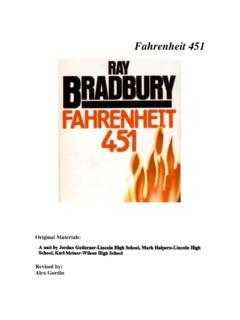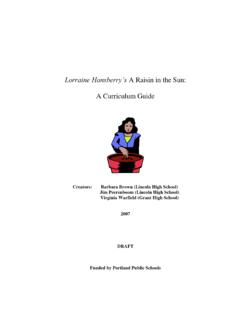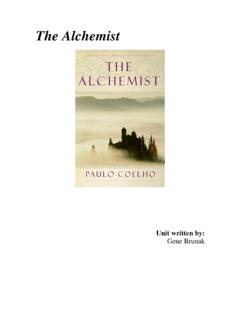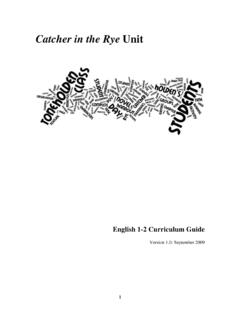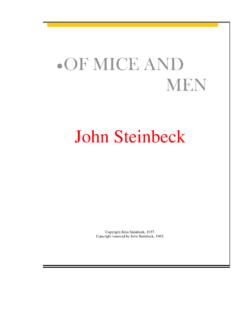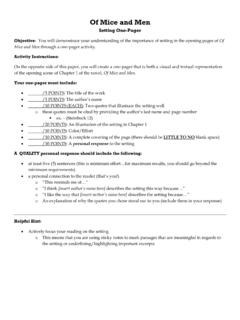Transcription of Of Mice and Men - Portland Public Schools / Home
1 of mice and men Original Unit written by Amy Botula, Tracy Groom, Keith Higbee, Karl Meiner, Maggie Michaels, 2006 Edited by Kelly J. Gomes, 2010 2 Introduction to the Revision This revision focuses on the original guide s concentration on social and economic power in of mice and men , and the development of related themes through characterization. As the original introduction (included below for easy reference) states, this is not a comprehensive guide for an entire unit, but is a streamlined set of steps toward the literary analysis and Socratic seminar.
2 In this revision, a pre-assessment will provide early data on students skills, and the literary analysis prompts have been tiered to meet the needs of a variety of students. The data, and your knowledge of your students, will inform your choices for the activities, variations, and prompts chosen. You will also find additional supports or variations in the ELL, TAG, and Special Ed sections at the end of most lessons. Additionally, due to the content of the novella, a parental opt-out letter can be located in the original curriculum guide. 3 4 of mice and men Curriculum Guide Planning Template Stage 1 Desired Results Priority Standards (4-5 only): Number and brief summary Identify and analyze the development of themes Develop a thesis Support a position with precise and relevant examples and evidence Document sources using appropriate citation format Provide transitions to link paragraphs Create an organizing structure Variation in sentence structure, length, beginnings, to add interest to text Conventions Understandings Students will understand.
3 How to write a social commentary The definition of Social Capital The role that gender, race, education, class, and language play in determining the distribution of power in society Essential Questions How does Steinbeck s commentary on the balance of social and economic power still apply to our world today? How do these themes continue to shape our world and our understanding of each other? What is our responsibility to our fellow man? How are themes conveyed through character? Students will (facts and knowledge) Elements of a literary analysis thesis statement Elements of a strong literary analysis essay The historical context (Great Depression) of the novel Students will be able to.
4 (apply skills) Create a thesis statement Develop, and correctly cite support for the thesis statement How to analyze themes in a work of literature Organize their literary analysis Include transitional phrases/sentences Vary sentence structure Stage 2 Assessment Evidence Culminating Assessment: Literary Analysis Essay: How character and imagery inform the theme in of mice and men . Other Evidence Silent Discussion Thematic Posters Haves and Have Nots Observation Journal Socratic Seminar 5 Stage 3 -- Learning Plan of mice and men Activity Title Priority Standards This Guide Original Guide Lesson #1: Essential Question Identify and analyze the development of themes 8 Lesson #2: Haves and Have Nots Observation Journal (PPS) Draw from both primary and secondary sources to gather information Compare and contrast information on the same topic, making perceptive connections 10 14 Lesson #3.
5 Carousel Gathering Evidence Strategy (PPS) Draw from both primary and secondary sources to gather information (PPS) Analyze the way in which a work is related to themes and issues of its historical period 11 9 Lesson #4: Thematic Posters Develop a thesis Support a position with precise and relevant examples and evidence Identify and analyze the development of themes 13 24 Lesson #5: Pre-Assessment Develop a thesis Support a position with precise and relevant examples and evidence Identify and analyze the development of themes 14 Lesson #6: Developing Thesis Statements & Prompts Develop a thesis 19 19 Lesson #7: Creating Streamlined Quotes & Embedding Quotes Activity Document sources using appropriate citation format.
6 Support a position with precise and relevant examples and evidence 21 26 Lesson #8: Transition/Topic Sentence Workshop Provide transitions to link paragraphs Use organizational structures 22 32 Lesson #9: Peer Review for Thesis & Topic Sentences Develop a thesis Use organizational structures 25 37 Lesson #10: The colon & Semicolon Workshop Sentence Structure Conventions 26 41 6 Lesson#:11 Connecting: Observation Journals and of mice and men (PPS) Draw from both primary and secondary sources to gather information 27 Lesson#12: Socratic Seminar Using Essential Questions and Essays Identify and analyze the development of themes (PPS) Actively solicit another person s comment or opinion (PPS) Display appropriate turn-taking behaviors (PPS) Offer one s own opinion assertively without dominating & give reasons in support of opinion (PPS) Volunteer contributions & respond when solicited 30 Culminating Assessment.
7 Literary Analysis Identify and analyze the development of themes Develop a thesis Support a position with precise and relevant examples and evidence Document sources using appropriate citation format Provide transitions to link paragraphs Create an organizing structure Variation in sentence structure, length, beginnings, to add interest to text Conventions 41 Lesson # 13 Unit Reflection Identify and analyze the development of themes 44 Resources 46 7 Academic Vocabulary The vocabulary used extensively in this unit on of mice and men : Theme Social capital Social commentary Inequity Gender Social class Analysis Thesis Evidence Citations MLA format Topic Sentence Transition/transitional Quotations Embedded Quotes Blocked Quotes Paraphrased Evidence Streamlined Content Background Knowledge: The American Dream Migrant Immigrant Great Depression Wall Street crash Dust Bowl FDR s New Deal work cards 8 Lesson #1: Essential Questions *Duration: 80 minutes *Priority standards: Identify and analyze the development of themes *Brief overview of lesson.
8 Students explore the idea of social capital and the themes of the novel by first exploring the immediate society of school. *Materials needed: Student Handout: What is social commentary? and Social Capital in School Journals/notebooks Key vocabulary: Social commentary Social capital Theme Inequity Gender Social class Addressing Essential Question(s): How does Steinbeck s commentary on the balance of social and economic power still apply to our world today? How do these themes continue to shape our world and our understanding of each other? What is our responsibility to our fellow man?
9 How does an author communicate themes through setting and character? Hook/Anticipatory Set: Journal write: How do gender, race, ability, and class issues shape the way we view others and interact with others in the larger world? Think locally and globally. *Steps/Procedures: 1. Journal write from above 2. Distribute the What is Social Commentary handout. Read, explain, check for understanding. 3. Read Social Capital in School with your class. Then, in the space provided, give students an opportunity to make a list of what groups of people have power in their school, which groups have less power, and things students do to gain power.
10 4. Have students share their ideas with the class. Make a running list of the ideas and chunk them into themes. Be careful to note which themes will parallel those found in the book (friendship, loneliness, inequities, race, class, etc.). 5. Ask students to return to their journal write. Now, they should add a quickwrite that explores the social divisions within their school. What is unfair and needs to be changed? What could they do to improve these conditions? 6. Have students share in small groups. 9 7. Share one piece from each group out to the whole class. 8. Ask students to read the first three essential questions for the unit to frame their journey through the book.
